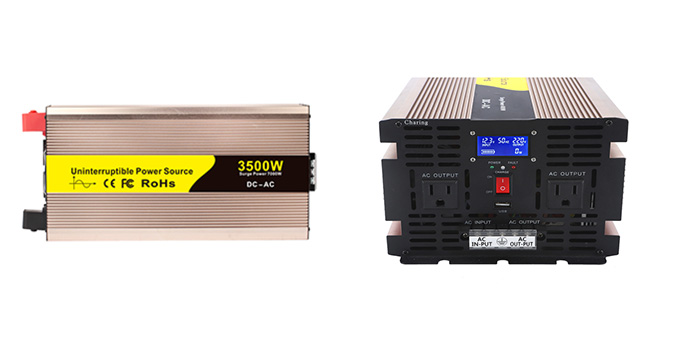An inverter, which is directly different from a transformer, means that the inverter can realize DC input and then output AC. The working principle is the same as that of a switching power supply. But the oscillation frequency is within a certain range, for example, this frequency is 50 Hz, and the output is AC 50 Hz. An inverter is a device that changes frequency. As an uninterruptible power supply, the ups can be perfectly combined with the inverter. So what should pay attention to when buying ups inverter? In this article, we will introduce in detail.

The ups inverter is a device that provides backup power to electronic equipment. It is mainly used to provide uninterrupted power supply to some equipment which requires high stability of power supply. An uninterruptible power supply, offers guaranteed power protection for connected electronics. Pure sine wave ups inverter can be used in PC, TV, refrigerator, digtial products and home appliances. Here are 7 points to look for when buying ups inverter.
- Understanding your power requirements. The first and most crucial step in choosing a ups power inverter is understanding your power requirements. This involves identifying the devices you need to protect and the total power consumption of these devices. Make a list of all the electronic devices you want to connect to the ups inverter, such as computers, routers, modems, servers, and other critical equipment. Each device has a power rating, usually measured in watts (W) or kilovolt-amperes (kVA), which indicates the amount of power it consumes. Add up the power ratings of all the devices to calculate the total power requirement. It is advisable to select a pure sine wave ups inverter that has a capacity of at least 20-30% higher than your total power requirement to accommodate any future expansion or unexpected power surges.
- Rated output voltage. Within the fluctuation range allowed by the specified input DC voltage, it represents the rated voltage value that the ups inverter should be able to output. The stability accuracy of the output rated voltage value is generally specified as follows: in steady state operation, the voltage fluctuation range shall be limited, for example, the deviation shall not exceed ± 3% or ± 5% of the rated value. The output voltage deviation shall not exceed ± 8% or ± 10% of the rated value under dynamic load mutation or other interference factors.
- Output voltage imbalance. Under normal working conditions, the ups inverter output three-phase voltage imbalance should not exceed a specified value, generally expressed by "%", such as 5% or 8%.
- Rated output frequency. Inverter output AC voltage frequency should be a relatively stable value, usually 50 Hz power frequency. The deviation should be within ± 1% under normal working conditions.
- Rated output current. It represents the rated output current of the ups inverter within the specified load power factor range. Some power inverter products give rated output capacity, expressed in VA or kVA. The rated capacity of an inverter is the product of the rated output current when the output power factor is 1 and the rated output voltage is the rated output current.
- Waveform distortion of output voltage. When the 3000W ups inverter output voltage is sinusoidal, the maximum allowable waveform distortion should be specified. Generally expressed as the total waveform distortion of the output voltage, the value should not exceed 5% (10% is allowed for single-phase output).
- Load power factor. It represents the capacity of the inverter with inductive load or capacitive load. Under sinusoidal conditions, the load power factor is 0.7-0.9 and the rating is 0.9.
- Expandability and scalability. When purchasing a ups solar inverter, consider its expandability and scalability. As your power needs grow, you may need to increase the ups's capacity or backup time. Some ups systems allow for additional battery packs to be added to extend backup time or have modular designs that enable capacity upgrades. Choosing a ups inverter that supports expansion can save you from purchasing a new unit in the future as your power requirements increase. Look for models with expansion slots or the ability to connect external batteries for extended runtime.
- Protection. Such as over voltage protection. For ups inverter without voltage stability measures, there should be output over voltage protection measures to make the negative intercept from the damage of output over voltage. And over current protection, the ups inverter over current protection, should be able to ensure that the load short-circuit or current exceeds the allowable value of the timely action, so that it is not damaged by the surge current. Home power inverter provides ups inverter with different power, ups inverter is equipped with pure sine wave output.
Buying a ups power inverter is a critical decision that requires careful consideration of various factors. By understanding these factors and evaluating your specific needs, you can choose a UPS inverter that provides reliable backup power and protects your electronic devices from power disturbances. Remember that investing in a quality ups inverter is not just about buying a piece of equipment; it's about ensuring the continuity of your operations and safeguarding your valuable equipment and data.
